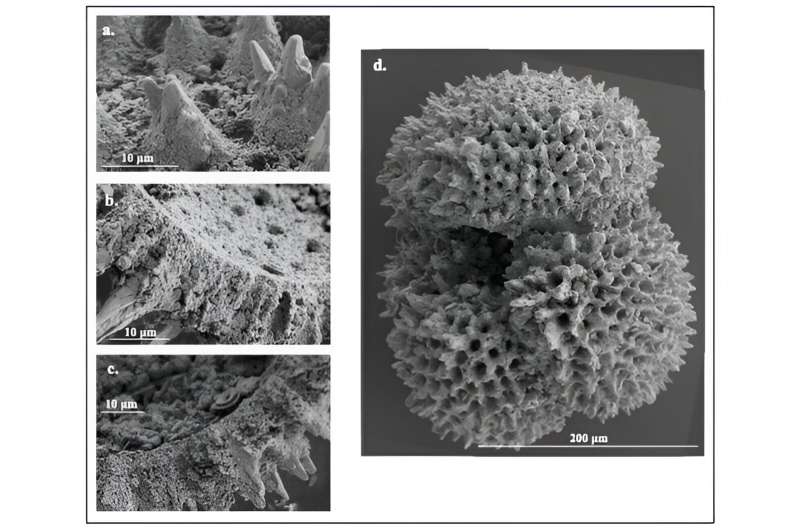This article has been reviewed according to Science X's editorial process and policies. Editors have highlighted the following attributes while ensuring the content's credibility:
fact-checked
peer-reviewed publication
trusted source
proofread
Microscopic fossilized shells reveal ancient climate change patterns

At the end of the Paleocene and beginning of the Eocene epochs, between 59 to 51 million years ago, Earth experienced dramatic warming periods, both gradual periods stretching millions of years and sudden warming events known as hyperthermals.
Driving this planetary heat up were massive emissions of carbon dioxide (CO2) and other greenhouse gases, but other factors like tectonic activity may have also been at play.
New research led by University of Utah geoscientists pairs sea surface temperatures with levels of atmospheric CO2 during this period, showing the two were closely linked. The findings also provide case studies to test carbon cycle feedback mechanisms and sensitivities critical for predicting anthropogenic climate change as we continue pouring greenhouse gases into the atmosphere on an unprecedented scale in the planet's history.
The research is published in the journal Proceedings of the National Academy of Sciences.
"The main reason we are interested in these global carbon release events is because they can provide analogs for future change," said lead author Dustin Harper, a postdoctoral researcher in the Department of Geology and Geophysics. "We really don't have a perfect analog event with the exact same background conditions and rate of carbon release."
But the study published Monday suggests that emissions during two ancient "thermal maxima" are similar enough to today's anthropogenic climate change to help scientists forecast its consequences.
The research team analyzed microscopic fossils—recovered in drilling cores taken from an undersea plateau in the Pacific—to characterize surface ocean chemistry at the time the shelled creatures were alive. Using a sophisticated statistical model, they reconstructed sea surface temperatures and atmospheric CO2 levels over a 6-million-year period that covered two hyperthermals, the Paleocene-Eocene Thermal Maximum, or PETM, 56 million years ago and Eocene Thermal Maximum 2, ETM-2, 54 million years ago.
The findings indicate that as atmospheric levels of CO2 rose, so too did global temperatures.
"We have multiple ways that our planet, that our atmosphere is being influenced by CO2 additions, but in each case, regardless of the source of CO2, we're seeing similar impacts on the climate system," said co-author Gabriel Bowen, a University of Utah professor of geology and geophysics.
"We're interested in how sensitive the climate system was to these changes in CO2. And what we see in this study is that there's some variation, maybe a little lower sensitivity, a lower warming associated with a given amount of CO2 change when we look at these very long-term shifts. But overall, we see a common range of climate sensitivities," said Bowen.
Today, human activities associated with fossil fuels are releasing carbon 4 to 10 times more rapidly than occurred during these ancient hyperthermal events. However, the total amount of carbon released during the ancient events is similar to the range projected for human emissions, potentially giving researchers a glimpse of what could be in store for us and future generations.
First, scientists must determine what happened to the climate and oceans during these episodes of planetary heating more than 50 million years ago.
"These events might represent a mid- to worst-case scenario kind of case study," Harper said. "We can investigate them to answer what's the environmental change that happens due to this carbon release?"
Earth was very warm during the PETM. No ice sheets covered the poles, and ocean temperatures were in the mid-90s degrees Fahrenheit.
To determine oceanic CO2 levels, the researchers turned to fossilized remains of foraminifera, a shelled single-cell organism akin to plankton. The research team based the study on cores previously extracted by the International Ocean Discovery Program at two locations in the Pacific.
The foram shells accumulate small amounts of boron, the isotopes of which are a proxy reflecting CO2 concentrations in the ocean at the time the shells formed, according to Harper.
"We measured the boron chemistry of the shells, and we're able to translate those values using modern observations to past seawater conditions. We can get at seawater CO2 and translate that into atmospheric CO2," Harper said. "The goal of the target study interval was to establish some new CO2 and temperature records for the PETM and ETM-2, which represent two of the best analogs in terms of modern change, and also provide a longer-term background assessment of the climate system to better contextualize those events."
The cores Harper studied were extracted from the Shatsky Rise in the subtropical North Pacific, which is an ideal location for recovering ocean-bottom sediments that reflect conditions in the ancient past.
Carbonate shells dissolve if they settle into deep ocean, so scientists must look to underwater plateaus like Shatsky Rise, where the water depths are relatively shallow. While their inhabitants were living millions of years ago, the foraminifera shells record the sea surface conditions.
"Then they die and sink to the sea floor, and they're deposited in about two kilometers of water depth," Harper said. "We're able to retrieve the complete sequence of the dead fossils. At these places in the middle of the ocean, you really don't have a lot of sediment supply from continents, so it is predominantly these fossils and that's all. It makes for a really good archive for what we want to do."
More information: Harper, Dustin T., Long- and short-term coupling of sea surface temperature and atmospheric CO2 during the late Paleocene and early Eocene, Proceedings of the National Academy of Sciences (2024). DOI: 10.1073/pnas.2318779121
Journal information: Proceedings of the National Academy of Sciences
Provided by University of Utah





















